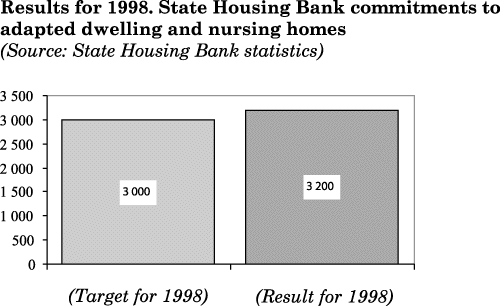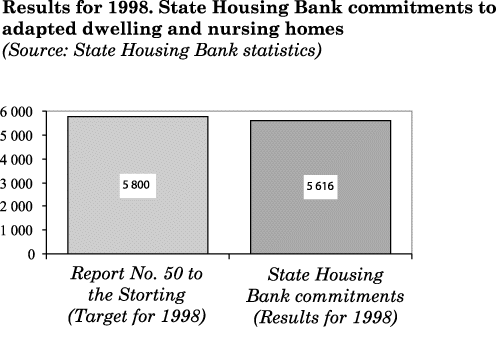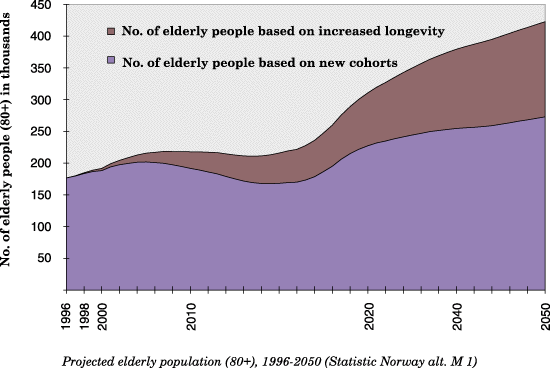Security - Respect - Quality.
Historisk arkiv
Publisert under: Regjeringen Bondevik I
Utgiver: Sosial- og helsedepartementet
Plan of Action for the Elderly 1998-2001 (I-0907 E)
Brosjyre/veiledning | Dato: 29.06.1999
Security - Respect - Quality
Action plan for care of the elderly 1998-2001
Table of contents
- 1 Action plan for care of the elderly: Security - respect - quality
- 2 Implementing the action plan
- 3 Results of the action plan for 1998
- 4 Further work on the action plan
1. Action plan for care of the elderly: Security - respect - quality
In 1997 the Storting (Norwegian parliament) adopted a four-year action plan for local authority nursing and care services. The plan is set out in a Government White Paper entitled "Report No. 20 to the Storting (1996-97), Action Plan for Care of the Elderly, Security - Respect - Quality". The plan, which runs from 1998 to 2001, sets out concrete objectives for the development of local authority nursing and care services. The plan entails use of central government funds to achieve these objectives.
The overall need for nursing and care services is expected to increase. This is related to the age structure of the population, especially the increase in the number of elderly people above the age of 80.
In the years immediately ahead the number of people above the age of 80 will steadily increase up to 2007 and subsequently fall in the period to 2017. Thereafter the number of elderly people above the age of 80 is expected to rise relatively steeply, especially in the decade following 2025. The size of the 80+ section of the population will also be affected by rising longevity.
The main challenges and tasks facing nursing and care services in the years immediately ahead can be summarised as follows:

- To increase capacity through new residential construction and new nursing and care posts
- To improve the quality of local nursing and care services
- To ensure uniform local authority provision of nursing and care services throughout the country
- To improve central government policy instruments
1.1 Core aims of the action plan
- to provide nursing and care services that ensure the elderly a secure and, to the maximum possible extent, a worthy and independent life
- to ensure elderly persons' ability to live in their own home for as long as possible
- to provide sufficient capacity to ensure that services are available when and where needed
1.2 The general objectives for the action plan are:
- to ensure high-quality nursing and care services adapted to the needs of the individual
- to strengthen the scope and quality of the services provided
- to develop an integrated, flexible range of services
- to provide uniform facilities nationwide, independent of home locality, income and resources.
- to provide greater scope for user participation and choice in relation to service provision
1.3 The concrete targets, based on 1.1 and 1.2, are:
- 6,000 new posts for services in the home in the period 1998-2001.
- 7,200 new specially adapted dwellings in the period 1998-2001.
- 6,000 additional single-occupant rooms from 1998 to 2002 to attain the objective set for such accommodation. This presupposes 280 new posts in the period 1998-2002.
- 5,000 more places offering 24-hour nursing and care (in nursing homes or specially adapted dwellings featuring 24-hour services) in the period 1998-2001 to keep pace with the increase in the numbers of elderly people. This presupposes a further 4,500 posts by 2001.
- 1,400 more places offering 24-hour nursing and care services in the period 1998-2001 to ensure a minimum level of nursing and care service provision by local authorities. This programme will be targeted at financially disadvantaged local authorities. A further 1,250 posts will be required in 2001.
- 4,800 places in the period 1998-2001 to replace worn-down nursing and old-people's homes.
Local authorities will continue to be responsible for shaping and developing nursing and care services in the future. To resolve the tasks facing the nursing and care sector, facilities will need to be varied and flexible. For this reason local authorities should as far as possible design and develop nursing and care facilities with a view to the conditions and needs present in the particular district. The action plan lays a basis for introducing a chain of programmes ranging from help in the recipientÕs home and in adapted dwellings to round-the-clock nursing and care in suitable accommodation (nursing home or the equivalent). Each local authority will itself decide the content and design of the services it provides.
2. Implementing the action plan
The Ministry of Health and Social Affairs is responsible for implementing the action plan.
Close collaboration has been established with the county governors who will be responsible for implementing the action plan in the individual county in conjunction with the chief county medical officers. Their work involves informational and advisory activity as well as monitoring, approval and control of the use made of central government grants.
2.1 Policy instruments
To ensure that the objectives of the action plan are attained, the central administration will prepare the ground for local authorities to provide users with the range of services they need. It will do this by means of financial and legal policy instruments as well as by imposing planning requirements on local authorities.
2.2 Requirements on local authority planning
Local authorities are required to prepare separate plans for nursing and care services which can subsequently be incorporated in their ordinary planning and budget programmes.
2.3 Financial instruments
The overall project is estimated to cost NOK 30 billion over the four-year period: NOK 10 billion on operations and about NOK 20 billion on investment. Earmarked funds will be made available to local authorities to implement the action plan.
2.3.1 Operating grants
Operating grants (totalling NOK 2.1bn for 1999) are allocated direct to the local authorities. The weightiest allocation criterion is the number of elderly people above the age of 80 in the community. The grants are stepped up each year for the duration of the plan. The Storting has made it clear that the funds must generate new activity with a basis in local authority planning. Funds will be withheld in cases where a local authority is unable to point to increased activity in the health and social services sector.
Grants are also available for disbursement on a discretionary basis. These grants are primarily intended to help local authorities with weak finances and poorly developed services. Local authorities which put services in place before the action plan went into effect, and incurred major investment outlays in the process, also qualify for a grant.
2.3.2 Investment grants
Investment grants are awarded to local authorities to facilitate the construction and refurbishment of dwellings and institutional accommodation. They take the form of start-up grants and grants to cover payment of interest and instalments on loans over the term of loans raised. The grants will altogether amount to NOK 740,000 for specially adapted dwellings and NOK 830,000 for places in nursing homes.
The grants are administered by the State Housing Bank.
2.4 Legal instruments
The following programmes are also incorporated in the action plan:
- The Storting has decided to propose regulations giving all elderly people the right to a single-occupant room as from 2003.
- Regulations governing the quality of nursing and care services, which went into force in May 1997, are being amended as necessary, including an obligation to spell out the details of decisions to admit elderly people to nursing homes.
- Steps will be taken to harmonise the Municipal Health Services Act and the Social Services Act with a view to bringing about a common body of rules for nursing and care services.
- The Storting has requested a report on the issue of equal treatment of payment schemes for medicine, aids and housing allowances for specially adapted dwellings and nursing homes. The ministry will prepare the requested report as part of its work on NOU (Norwegian Official Report) 17:1997.
- The Ministry of Health and Social Affairs has introduced Proposition No. 13 (1998-99), entitled The Health Personnel Act, to the Odelsting. This Bill set out general requirements as to the professional practice of authorised personnel as well as more detailed requirements on, and rights of, such personnel.
3. Results of the action plan for 1998
3.1 Investment
In 1998 construction of 5,616 residential units was started. They comprise 3,865 specially adapted dwellings (69%) and 1,751 places at nursing homes (31%).

3.2 Measurable results of the operating grant
A total of 3,200 new posts (person-years) were established in local authority nursing and care services in 1998. 51% were allotted to services in the home, 37% to institutions and 12% to other purposes.

3.3 Assesment of results after the first year of the action plan period
Considering that 1998 was the first year of the action plan period, the level of the resultant local authority activity both on the planning and development side was very high. The number of commitments made by the State Housing Bank in 1998 - just below the target - showed an increase of all of 126% on the 1997 figure. The number of new posts in the nursing and care sector was also well in line with the action plan's target. Moreover, many local authorities spent grant funds on training and skills-upgrading and on strengthening other operating functions in the elderly care sector.
The distribution of new posts on institutions and on services in the home also corresponds well with investments undertaken in 1998, and indicates that construction of specially adapted dwellings is being followed up with increased staffing levels and an improved range of services, as indeed was the intention of the action plan.
4. Further work on the action plan
The Ministry of Health and Social Affairs will monitor the progress of the action plan in light of the target- and result requirements set for the grant schemes in the government budget. After a period of two years the ongoing assessments and follow-ups will be supplemented with a review and appraisal of the instruments applied to implement the action plan. This review will be carried out in light of local authorities' development plans and the respective county governors' assessment of these plans.
For further information see the ministry's web pages at odin.dep.no. Details can also be obtained by contacting the following persons at the Ministry of Health and Social Affairs: Project Manager Steinar Barstad on 22 24 86 89; Adviser Per Gammelsæther on 22 24 86 02; and Adviser ¯yvind Brandt on 22 24 85 78.
Department of Social and Health Care Policy
Ministry of Health and Social Affairs
Oslo, March 1999
Much of the responsibility for implementing the action plan at the county level rests with the respective county governor offices. These offices can be contacted for details of local action-plan programmes.